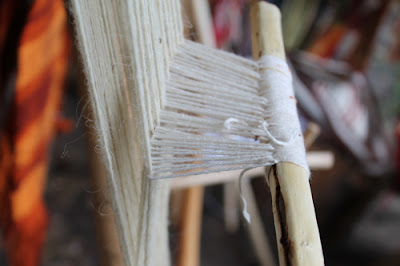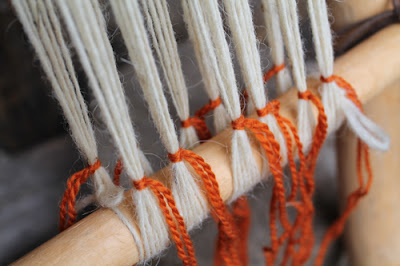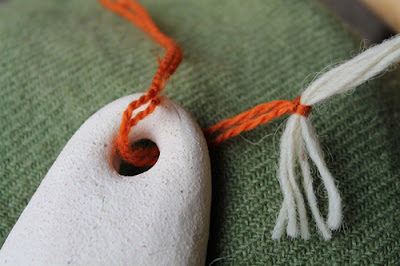Vertical looms – creating the warp.
Today, during the Biskupin Festival, I finished a long-hanging fabric and my vertical looms are finally free. I also had an idea on how to simplify the creation of the warp. The edge selvedge worked well for the apron, but it will not be needed in all cases. In addition, the warping and weaving of the edge selvedge while adding the actual fabric to the warp thread is quite time-consuming. Certainly compared to what I did today.
I started of course with a change of plans, because the sun had set and it was starting to rain. I intended to use sticks stuck in the ground as a snowman – 2 sticks driven in at the same distance as the future warp will be will be enough. I moved from the lawn to the roof and simply used a loom:
The yarn is wrapped around 2 sticks and is about 1m long. The beginning and end are at the bottom. Each loop creates a figure eight, i.e. the threads cross each other. This can be seen by adding the sticks in the middle:
and here's a closer look:
Above the intersection of the threads I placed a half-harness:
Then I divided the warp into strands of 6 threads, and put a loop of yarn on each strand at the bottom:
At the top I connected the loops with 2 pieces of yarn. (It was supposed to be a bit different, next time I will try to improve this element, but I will not mix it up... for now it is good :))
Once all the warp threads were properly tied, I cut the loops at the bottom. Using a thin strip, I moved the warp to the center of the loom – I tied the strip together with the warp to the shaft. I attached each warp strand to a clay weight using a “technical” yarn, simply tying it into a bow 😀 (photos taken on my knee ;P)
A loop like that on the warp is really enough – no knots… a loop that tightens itself. A method proven in weaving selvedges, even those made of slippery mercerized cotton.
I separated the weights by placing them on both sides of the lower crossbar:
Unfortunately, the crossbar is not visible – my mistake 😉
At the end there will be a beginning – the beginning of a new fabric, that is, the first centimeters of a new creation.
It won't be an ambitious fabric - short and narrow. And that's good, I have to weave it quickly, because I already know what I've "messed up". Don't make the warp like that! ;P













What a weaving marvel!!!!!!!!!!!!!!!
Hey, cool tutorial! I have a question before I start. It's about point:
"Then I divided the warp into strands of 6 threads, and on each strand at the bottom I put a loop of yarn" and cut the warp at the bottom to hang the weights. What is the advantage of weights over if the warp was wound on the lower and upper beam as at the beginning? Is it just a matter of historical importance, does it have any advantages? I can't really deduce. Thanks in advance for your answer 🙂